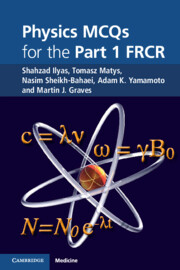Book contents
- Frontmatter
- Contents
- Preface
- Acknowledgements
- 1 Basic physics
- 2 Radiation hazards and protection
- 3 Imaging with X-rays
- 4 Film-screen radiography
- 5 Digital radiography
- 6 Fluoroscopy and mammography
- 7 Nuclear medicine
- 8 Computed tomography
- 9 Imaging with ultrasound
- 10 Magnetic resonance imaging
- Bibliography
- Index
3 - Imaging with X-rays
Published online by Cambridge University Press: 05 July 2011
- Frontmatter
- Contents
- Preface
- Acknowledgements
- 1 Basic physics
- 2 Radiation hazards and protection
- 3 Imaging with X-rays
- 4 Film-screen radiography
- 5 Digital radiography
- 6 Fluoroscopy and mammography
- 7 Nuclear medicine
- 8 Computed tomography
- 9 Imaging with ultrasound
- 10 Magnetic resonance imaging
- Bibliography
- Index
Summary
Regarding subject contrast in radiography, which of the following are correct?
It depends on the thickness of the structure being imaged
It depends on the linear attenuation coefficients of the structures being imaged
It increases with the tube kV
Contrast between low-atomic-number structures (e.g. fat and muscle) is strongly affected by changes in the tube kV
Contrast between air and soft tissue is due to differences in their atomic numbers
Concerning radiographic contrast:
Attenuation of the X-ray beam depends upon the degree of Bremsstrahlung in the tissue
Most structures on a chest radiograph exhibit good radiographic contrast
In principle, contrast media have the same effect on demonstrating contrast between tissues as increasing the peak kV (kVp)
All contrast media attenuate X-rays to a higher degree than the tissue
Positive-contrast media should generally have high atomic numbers to maximize the degree of photoelectric absorption
Which of the following are correct for positive-contrast media?
They should ideally have an absorption edge just to the left of the major part of the beam spectrum
Barium has a K-absorption edge of approximately 23 keV
Iodine has a lower atomic number than barium
Iodine most effectively attenuates photons with energies close to 37 keV
They may produce characteristic radiation
Concerning magnification:
It occurs because X-rays converge on the object
[…]
- Type
- Chapter
- Information
- Physics MCQs for the Part 1 FRCR , pp. 28 - 40Publisher: Cambridge University PressPrint publication year: 2011



